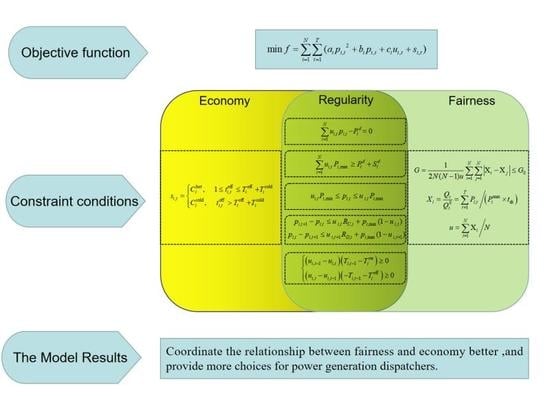A Gini Coefficient-Based Impartial and Open Dispatching Model
Abstract
:1. Introduction
Literature Review and Discussion
- (1)
- The fairness of the unit’s generation schedule is over-emphasized, so that the system operation economic optimization space is reduced, which is not conducive to the resources optimizing configuration [20];
- (2)
- There is a lack of coordination between fairness and economy, which limits the diversity of the optimization objectives of the dispatching. As a result, the different fairness requirement in the different processes of scheduling is difficult to meet.
- (1)
- The differences among units’ generation energy progresses can be guaranteed in the specified range, which could give consideration to the interests of all the units;
- (2)
- The balance between economy and fairness can be achieved by adjusting the value of the Gini coefficient, thereby the economic optimizing space in the dispatching could be effectively expanded, and the overall operational economy is improved.
2. Impartial and Open Dispatching and Gini Coefficient
2.1. Impartial and Open Dispatching
- (1)
- Abide by the relevant laws and regulations of the state, implement the national energy, environmental and industrial policies, and conscientiously implement the relevant national and industrial standards and regulations;
- (2)
- Ensure the safety, quality, and economic operation of the power system and give full play to its capabilities to meet the needs of the community;
- (3)
- Safeguard the legitimate rights and interests of power production enterprises, power grid operating enterprises, and power users;
- (4)
- Give full play to the role of the market in regulating the allocation of electricity resources.
2.2. Gini Coefficient
2.2.1. Concept of Gini Coefficient
2.2.2. Characteristics of the Gini Coefficient
- (1)
- The Gini coefficient is of good observability, that is, fairness can be determined without comparing any data. When evaluating the fairness, the Gini coefficient ranges from 0 to 1, and the closer it is to 0, the fairer the distribution will be.
- (2)
- The calculation process of Gini coefficient is the processing of all data collection, which is more universal and reasonable than some other fair indicators such as extreme poor.
- (3)
- The Gini coefficient is an important international analysis index used to comprehensively investigate the income distribution differences among residents. It is an internationally recognized economic statistical index that can reasonably reflect the overall fairness.
3. Mathematical Model
3.1. Mathematical Modeling
3.1.1. Objective Function
3.1.2. Constraint Conditions
- (1)
- The power balance constraint of the system
- (2)
- The spinning reserve constraints of the system
- (3)
- The maximum and minimum output constrains
- (4)
- The ramp rate constraints
- (5)
- The minimum startup–shutdown time constraints
- (6)
- The startup–shutdown cost constraint
- (7)
- Generation fairness constraint
3.2. Solving Method
4. Simulation and Analysis
4.1. Simulation Condition
4.2. Simulation Results
4.2.1. Unit Commitment and Output Schedule
4.2.2. Simulation Results with Different Threshold Values of Gini Coefficient
4.2.3. Simulation Results with Different Dispatching Modes
5. Conclusions
- The proposed impartial and open dispatching model based on the Gini coefficient is an extended mode of the conventional dispatching model. The optimization space of system operation economy could be effectively improved on the premise of specifying fairness requirement by introducing the Gini coefficient in economics as an index to measure the fairness of electric energy completed progress in the form of constraint conditions.
- In power system operation, different levels of balance between economy and equity can be achieved by adjusting the threshold value of the Gini coefficient according to different levels of fairness demand, so as to provide more choices for scheduling department. Better balance between fairness and economy could be realized to improve the overall system operation efficiency. The recognition of the generation companies to the impartial and open scheduling scheme could be improved because of the use of the internationally recognized Gini coefficient indicator, which has the recommended fairness value range.
- The research in this paper is limited to the theoretical study of models and methods, and the proposed method cannot meet the computational requirements of optimal scheduling of large-scale power systems in terms of computational speed and computational convergence. However, the model presented in this paper has been put into trial operation in the monthly power generation scheduling in a provincial power grid in China. The next study content of the authors is to simplify the model and algorithm so that they could be applied to the actual dispatching work.
Author Contributions
Funding
Conflicts of Interest
References
- State Electricity Regulatory Commission. Interim Measures for Promoting Open, Fair and Equitable Power Dispatching; State Electricity Regulatory Commission: Beijing, China, 2004. [Google Scholar]
- Long, H.; Huang, J.J. Development Direction Analysis of Coal-fired Power Units’ Design Technology During the 13th Five-Year Plan. Power Gener. Technol. 2018, 39, 13–17. [Google Scholar]
- Zhao, W.; Xu, J.; Wang, R. Security, economy and fairness of power systems under power market conditions. China Electr. Power Educ. 2008, S1, 145–146. [Google Scholar]
- Sun, J. Economic Analysis of Technology Supervision at Electric Power Generating Enterprises. Power Gener. Air Cond. 2017, 38, 72–77. [Google Scholar]
- He, L.; Lv, H.F. Research on Optimal Dispatching of Multi-Microgrid Considering Economy. Power Gener. Technol. 2018, 39, 397–404. [Google Scholar]
- Li, Y.J.; He, Z.C.; Zhang, Q. Test and Evaluation of Power Quality in Thermal Power Plant. Power Gener. Technol. 2018, 39, 135–139. [Google Scholar]
- De la Nieta, A.A.S.; Gibescu, M. Day-ahead Scheduling in a Local Electricity Market. In Proceedings of the 2019 International Conference on Smart Energy Systems and Technologies (SEST), Porto, Portugal, 9–11 September 2019; pp. 1–6. [Google Scholar] [CrossRef]
- Dashti, H.; Conejo, A.J.; Wang, R.J. Weekly Two-Stage Robust Generation Scheduling for Hydrothermal Power Systems. IEEE Trans. Power Syst. 2016, 31, 4554–4564. [Google Scholar] [CrossRef] [Green Version]
- Jain, S.; Kanwar, N. Day ahead optimal scheduling of generators using Dynamic Programming method. In Proceedings of the 2019 8th International Conference on Power Systems (ICPS), Jaipur, India, 20–22 December 2019; pp. 1–6. [Google Scholar] [CrossRef]
- Toma, L.; Tristiu, I.; Bulac, C. Optimal generation scheduling strategy in a microgrid. In Proceedings of the 2016 IEEE Transportation Electrification Conference and Expo, Asia-Pacific, Busan, Korea, 1–4 June 2016; pp. 491–496. [Google Scholar]
- Nikmehr, N.; Ravadanegh, S.N. Optimal power dispatch of multi-microgrids at future smart distribution grids. IEEE Trans. Smart Grid 2015, 6, 1648–1657. [Google Scholar] [CrossRef]
- Gregoratti, D.; Matamoros, J. Distributed energy trading: The multiple-microgrid case. IEEE Trans. Ind. Electron. 2015, 62, 2551–2559. [Google Scholar] [CrossRef] [Green Version]
- Zhang, J.L.; Li, W.; Pan, Y. A Strategy for Balance of Medium-Term and Long-Term Electric Power and Energy in Fujian Province on the Dispatching Mode Conforming to Principles of Openness, Equity and Impartiality. In Proceedings of the Asia-Pacific Power and Energy Engineering Conference, Shanghai, China, 27–29 March 2012; pp. 1–7. [Google Scholar]
- Li, L.l.; Geng, J.; Yao, J.G. Model and Algorithm for Security Constrained Economical Dispatch in Equilibrium Power Generation Dispatching Mode. Autom. Electr. Power Syst. 2010, 34, 23–27. [Google Scholar]
- Yang, Z.H.L.; Tang, G.Q. A Generation Scheduling Optimization Model Suitable to Complete Period and Variable Intervals and Conforming to Principles of Openness, Equity and Justness. Power Syst. Technol. 2011, 35, 132–136. [Google Scholar]
- Zhu, Z.L.; Zhou, J.Y.; Pan, Y. Security Constrained Economic Dispatch Considering Balance of Electric Power and Energy. Proc. CSEE 2013, 33, 168–176. [Google Scholar]
- Pan, K. Coordination Optimization Dispatch and Its Evaluation in Wind Integrated Power Systems. Master’s Thesis, Huazhong University of Science and Technology, Wuhan, China, 2014. [Google Scholar]
- Jian, H.Y.; Kang, C.H.Q.; Du, B.Q. A Novel Approach to Assess Imparity and Openness of Power Dispatching in Electricity Market. Power Syst. Technol. 2005, 32, 26–32. [Google Scholar]
- Zhang, C.H.G.; Wang, X.L. Impartiality Indexes of Power Dispatching Based on Modified Weighed Coefficient of Variation. Electr. Power Technol. Econ. 2009, 21, 5–9. [Google Scholar]
- Li, W.D. On Frequency Response Control of Future Grid. Power Gener. Technol. 2018, 39, 84–89. [Google Scholar]
- Sun, F.; Zuo, X.F.; Qin, Y. Road Network Equilibrium Analysis Based on Section Importance and Gini Coefficient. Green Smart Connect. Transp. Syst. 2020, 617, 1119–1134. [Google Scholar]
- Dai, H.N.; Yao, E.J.; Liu, S.S. Flow inequality of freeway network based on Gini-coefficient. J. Transp. Syst. Eng. Inf. Technol. 2017, 17, 205–211. [Google Scholar]
- Li, W.D. The Application of Gini Coefficient in Regional Environmental Pollutants Distribution Plan. Gener. Technol. 2018, 39, 84–89. [Google Scholar]
- Wu, D.F.; Zeng, G.P.; Meng, L.G. Gini Coefficient-based Task Allocation for Multi-robot Systems with Limited Energy Resources. Environ. Sci. Inf. Appl. Technol. ESIAT 2010, 1, 426–429. [Google Scholar] [CrossRef]
- Dai, J.L.; Wang, P.; Wang, X. Discussion on Impartiality Index of Power Dispatching Based on Gini Coefficient. Autom. Electr. Power Syst. 2008, 32, 1–4. [Google Scholar]
- Zeng, F.; Wang, P. Fairness Coefficient Analysis of Power Dispatching in North China Area. Mod. Electr. Power 2010, 27, 78–81. [Google Scholar]
- Wei, X.H.; Hu, Z.H.Y.; Yang, L. An Analysis and Suggestions for Existing Evaluation Indices of Open and Impartial Power Dispatching. Autom. Electr. Power Syst. 2012, 20, 109–112. [Google Scholar]
- Li, S.H. Further explanation of the estimation method and decomposition of the Gini coefficient. Econ. Res. J. 2002, 5, 45–53. [Google Scholar]
- Xiong, J. A Comparative Analysis of Appraisal Method of Gini Coefficient. Res. Financ. Econ. Issues 2003, 1, 79–82. [Google Scholar]
- Ye, B.; Zhang, P.X.; Zhao, B. Multiobjective Hybrid Evolutionary Algorithm for Economic Load Dispatch. Proc. CSU EPSA 2007, 2, 66–72. [Google Scholar]
- Geng, J.; Xu, F.; Yao, J. Performance Analysis of Mixed-integer Programming Based Algorithm for Security Constrained Unit Commitment. Autom. Electr. Power Syst. 2009, 33, 24–27. [Google Scholar]
- Su, J.G.; Shu, X.; Xie, G.H. Linearization Method of Large Scale Unit Commitment Problem with Network Constraints. Power Syst. Prot. Control 2010, 38, 135–139. [Google Scholar]
- Cheng, C.H.P.; Liu, C.H.W.; Liu, C.H. Unit commitment by Lagrangian relaxation and genetic algorithms. IEEE Trans. Power Syst. 2000, 15, 707–714. [Google Scholar]
- Jiang, Z.H.M.; Guan, Q.M. The Process of Solving Optimization Problems Based on CPLEX and C++ Language. Comput. Knowl. Technol. 2015, 11, 49–50. [Google Scholar]
- Young, G.O. Synthetic structure of industrial plastics. In Plastics, 2nd ed.; Peters, J., Ed.; McGraw-Hill: New York, NY, USA, 1964; Volume 3, pp. 15–64. [Google Scholar]
- Chen, W.K. Linear Networks and Systems. Belmont; Wadsworth: Boston, MA, USA, 1993; pp. 123–135. [Google Scholar]
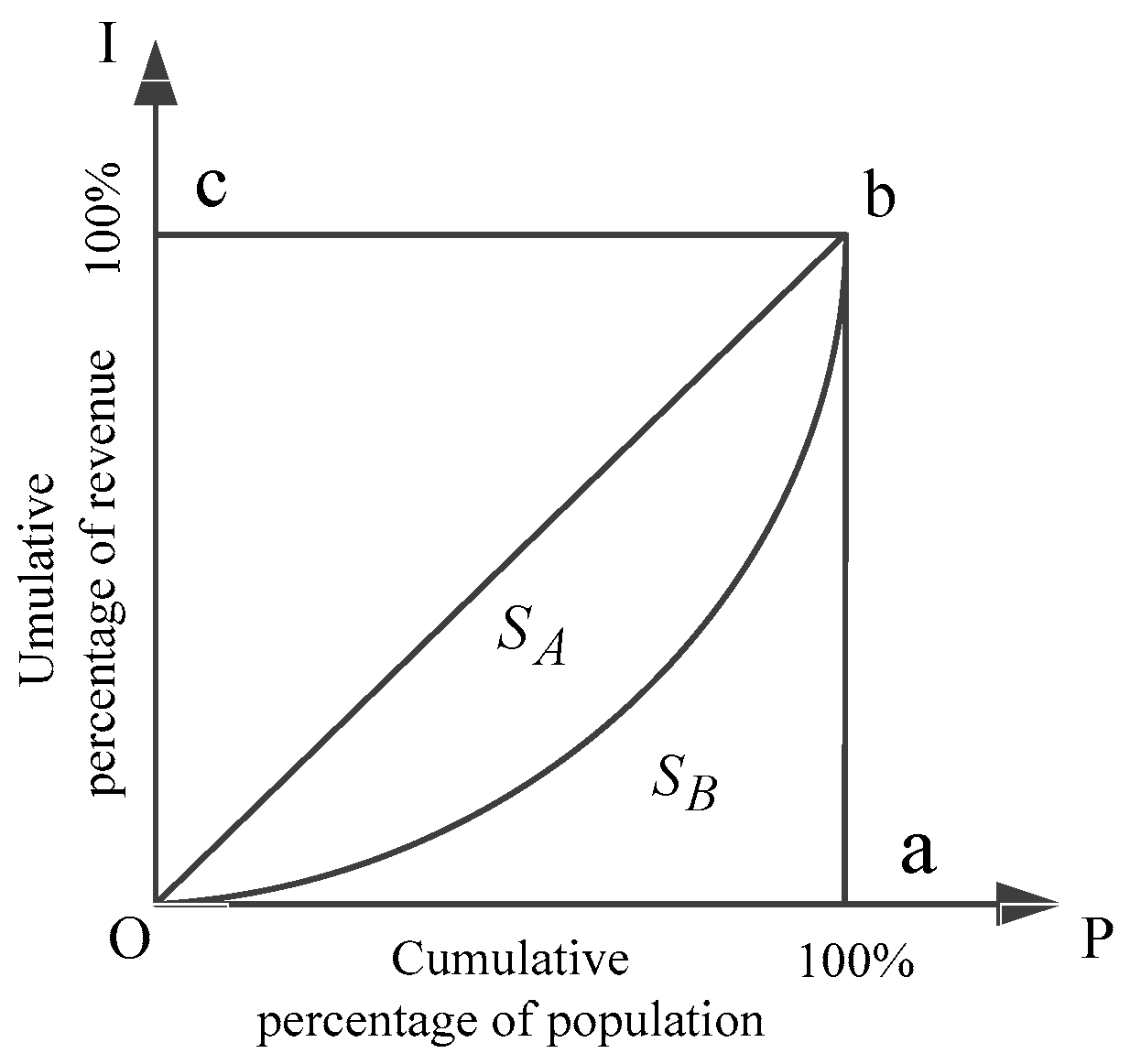
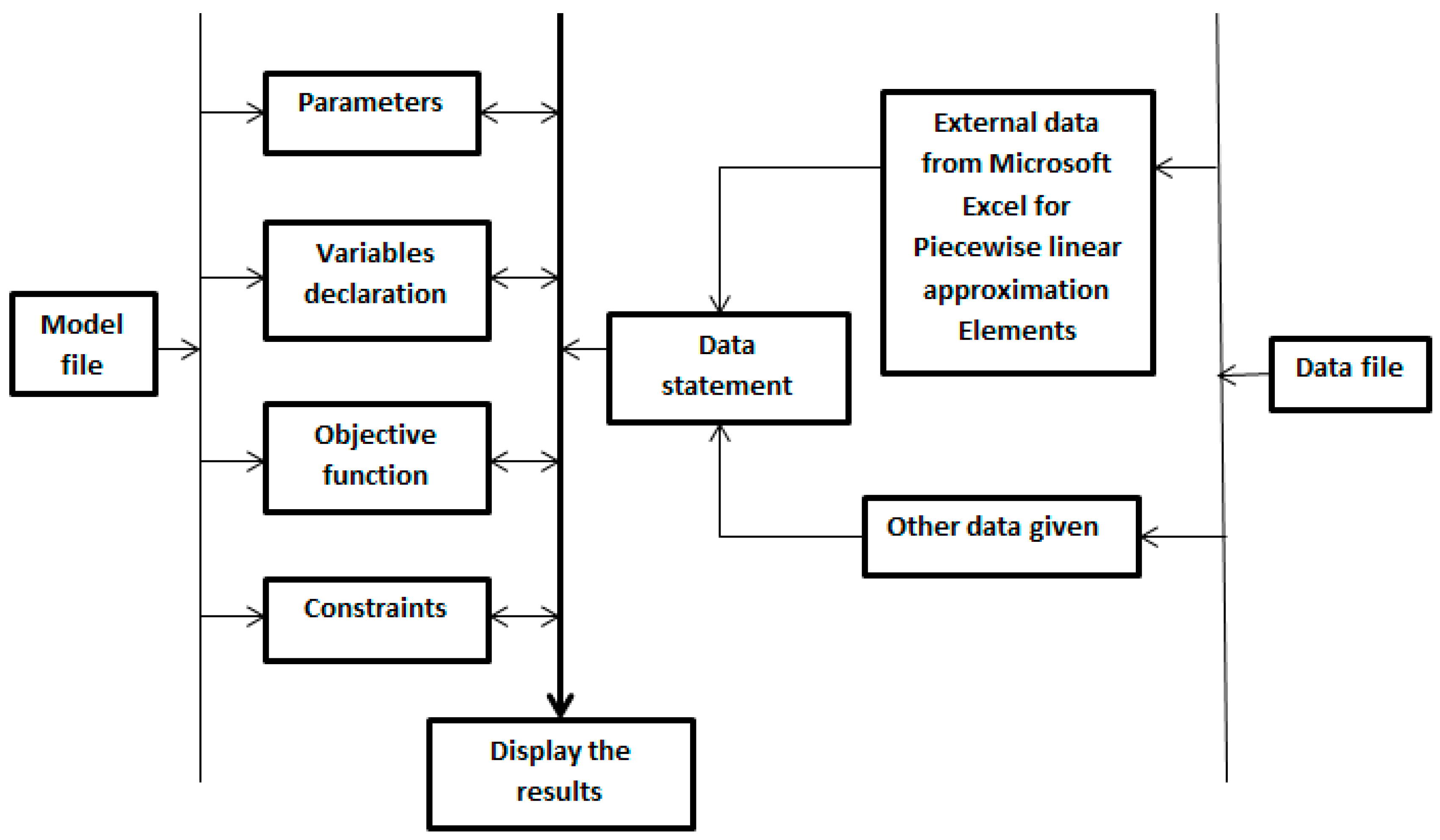
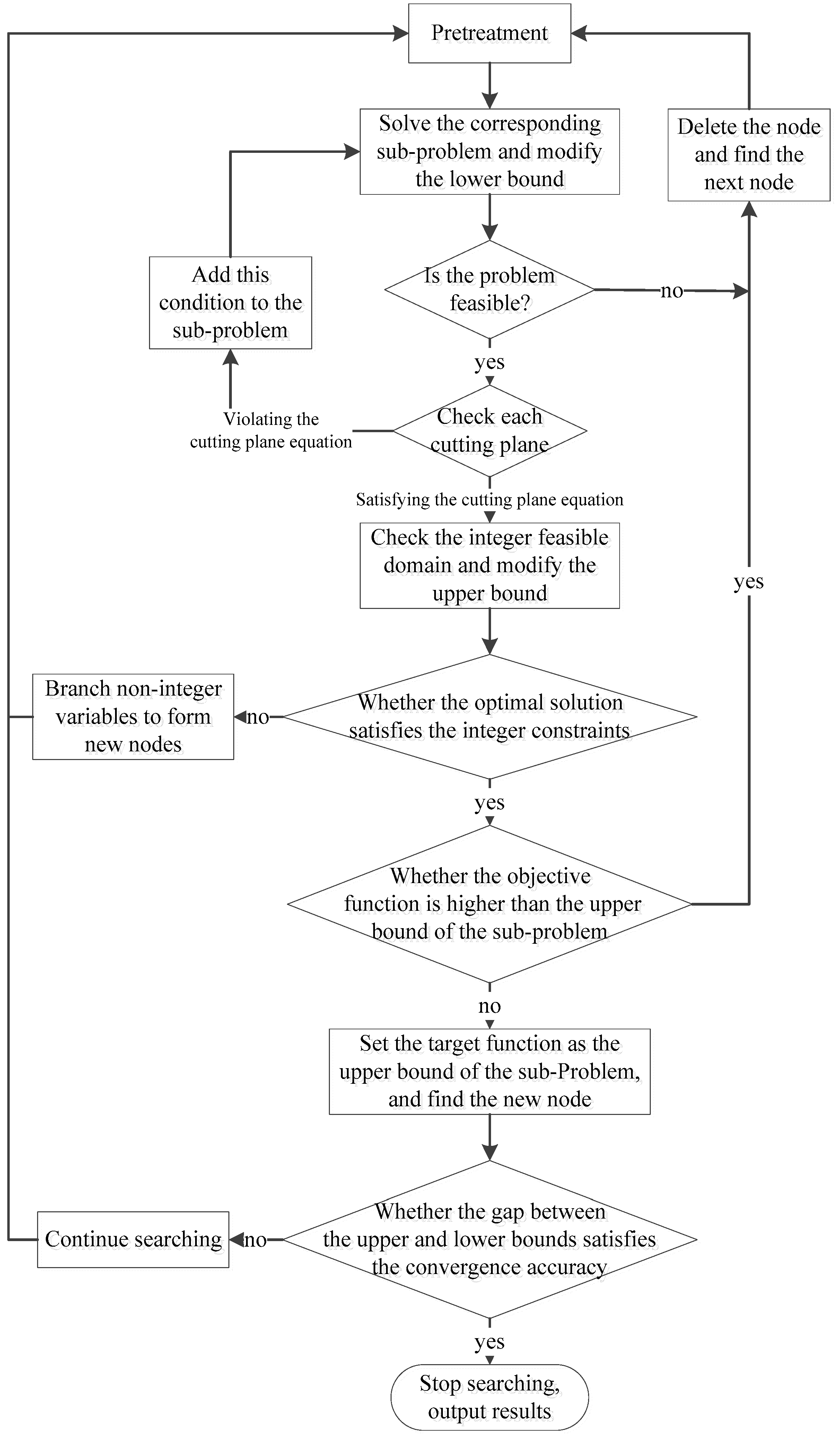
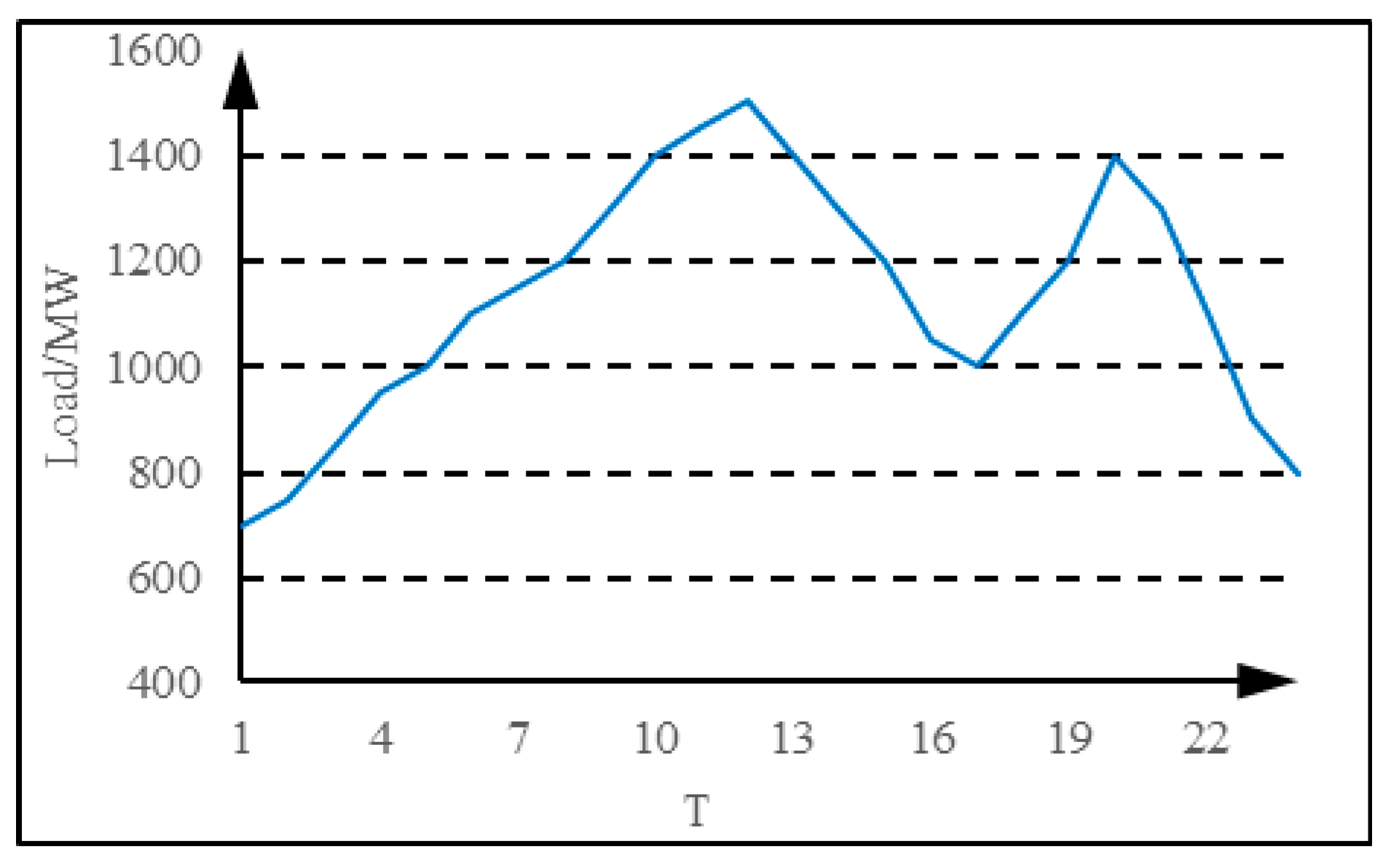

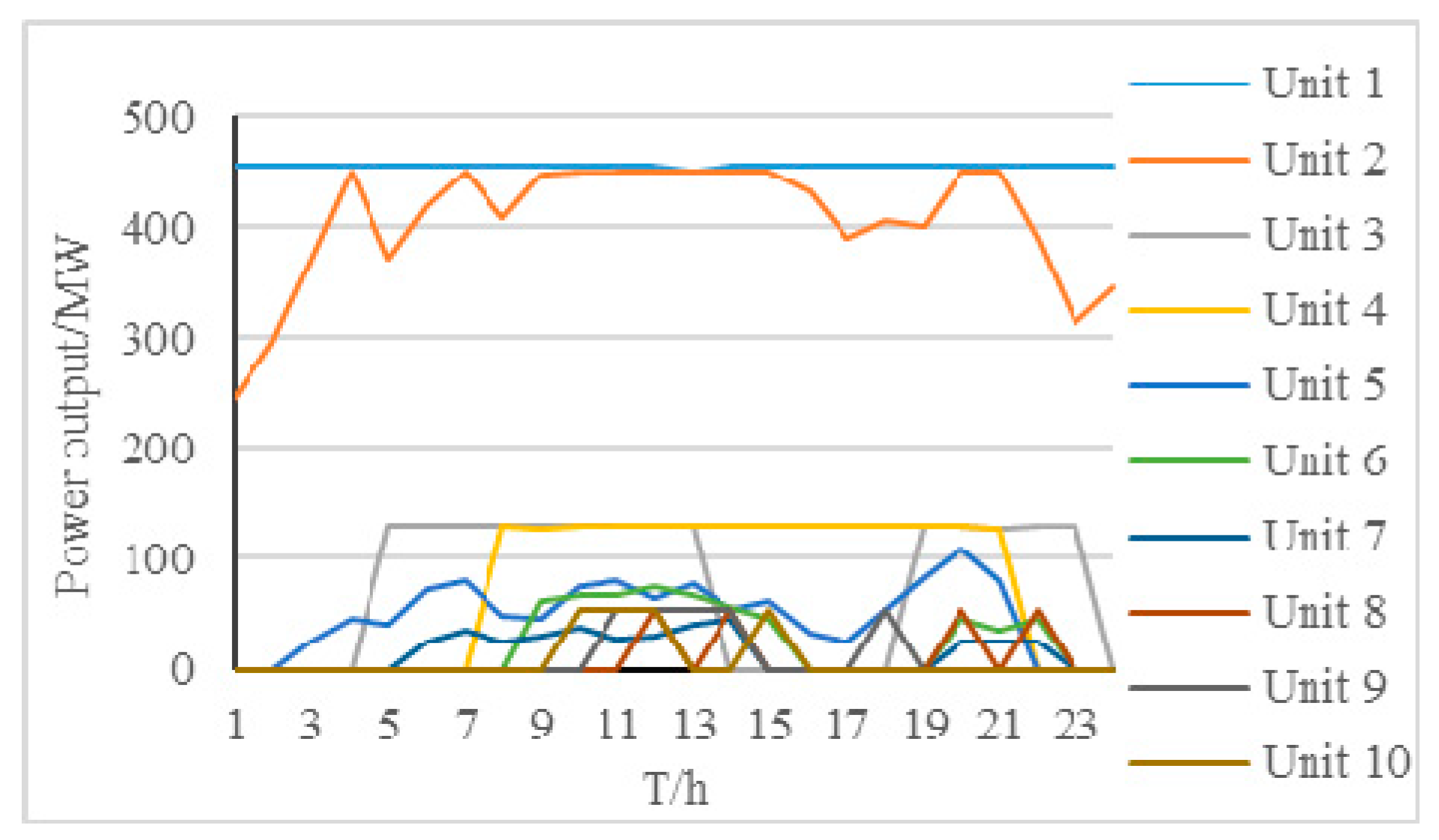
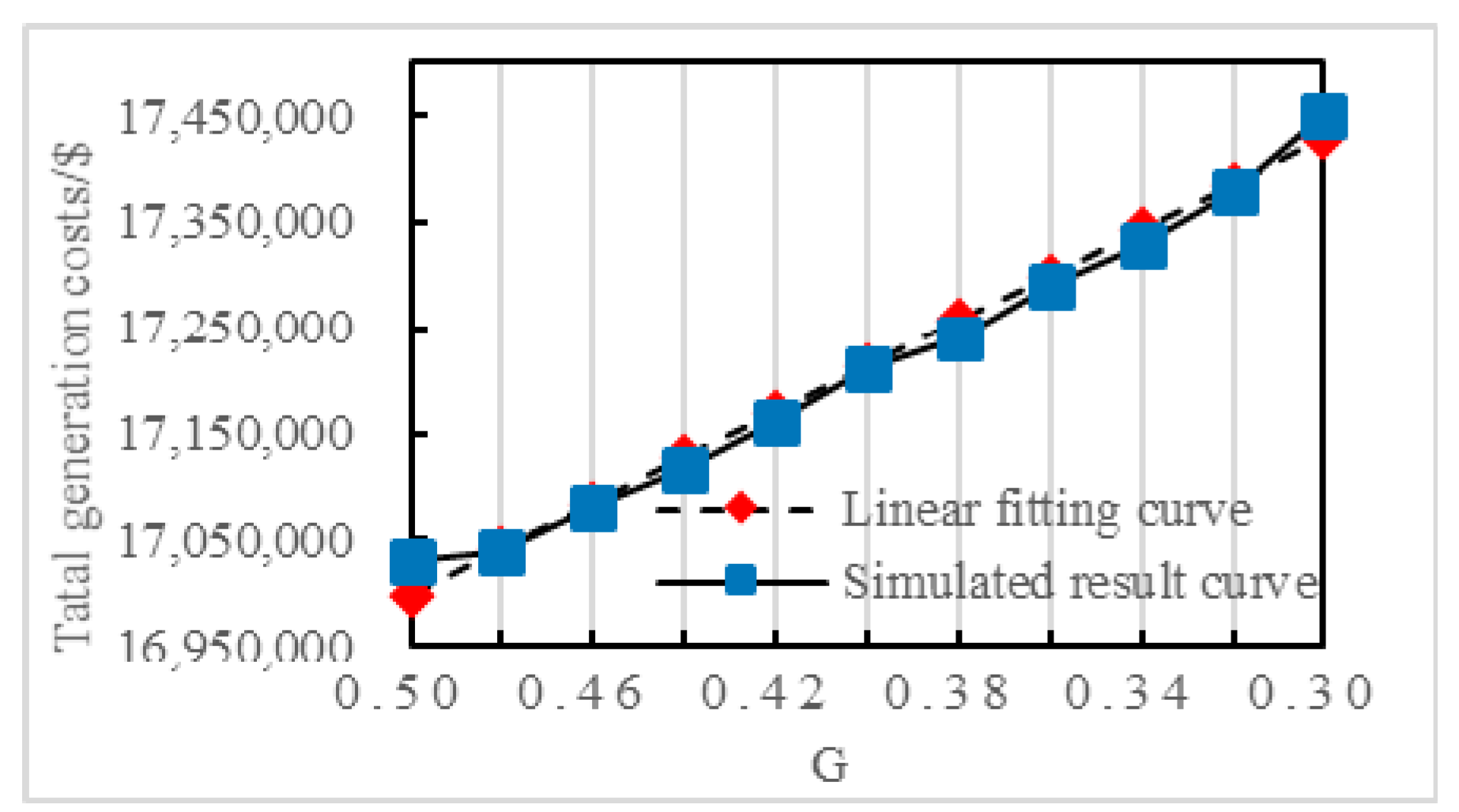

| Unit No. | Pmax | Pmin | a | b | c | Rup | ||||||
|---|---|---|---|---|---|---|---|---|---|---|---|---|
| 1 | 455 | 150 | 8 | 8 | 8 | 5 | 0.00048 | 16.19 | 1000 | 4500 | 9000 | 80 |
| 2 | 455 | 150 | 8 | 8 | 8 | 5 | 0.00031 | 17.26 | 970 | 5000 | 10,000 | 80 |
| 3 | 130 | 20 | 5 | 5 | −5 | 4 | 0.00200 | 16.60 | 700 | 550 | 1100 | 20 |
| 4 | 130 | 20 | 5 | 5 | −5 | 4 | 0.00211 | 16.50 | 680 | 560 | 1120 | 20 |
| 5 | 162 | 25 | 6 | 6 | −6 | 4 | 0.00398 | 19.70 | 450 | 900 | 1800 | 30 |
| 6 | 80 | 20 | 3 | 3 | −3 | 2 | 0.00712 | 22.26 | 370 | 170 | 340 | 10 |
| 7 | 85 | 25 | 3 | 3 | −3 | 2 | 0.00079 | 27.74 | 480 | 260 | 520 | 10 |
| 8 | 55 | 10 | 1 | 1 | −1 | 0 | 0.00413 | 25.92 | 660 | 30 | 60 | 5 |
| 9 | 55 | 10 | 1 | 1 | −1 | 0 | 0.00222 | 27.27 | 665 | 30 | 60 | 5 |
| 10 | 55 | 10 | 1 | 1 | −1 | 0 | 0.00173 | 27.79 | 670 | 30 | 60 | 5 |
© 2020 by the authors. Licensee MDPI, Basel, Switzerland. This article is an open access article distributed under the terms and conditions of the Creative Commons Attribution (CC BY) license (http://creativecommons.org/licenses/by/4.0/).
Share and Cite
Sun, L.; Zhang, N.; Li, N.; Song, Z.-r.; Li, W.-d. A Gini Coefficient-Based Impartial and Open Dispatching Model. Energies 2020, 13, 3146. https://doi.org/10.3390/en13123146
Sun L, Zhang N, Li N, Song Z-r, Li W-d. A Gini Coefficient-Based Impartial and Open Dispatching Model. Energies. 2020; 13(12):3146. https://doi.org/10.3390/en13123146
Chicago/Turabian StyleSun, Liang, Na Zhang, Ning Li, Zhuo-ran Song, and Wei-dong Li. 2020. "A Gini Coefficient-Based Impartial and Open Dispatching Model" Energies 13, no. 12: 3146. https://doi.org/10.3390/en13123146
APA StyleSun, L., Zhang, N., Li, N., Song, Z.-r., & Li, W.-d. (2020). A Gini Coefficient-Based Impartial and Open Dispatching Model. Energies, 13(12), 3146. https://doi.org/10.3390/en13123146



